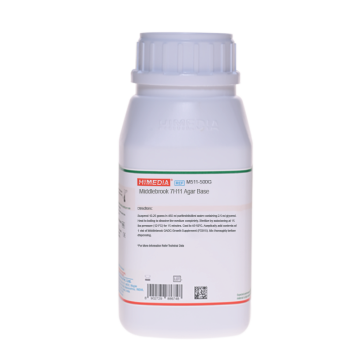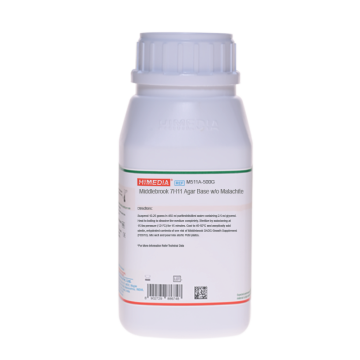 Your enquiry has been submitted
Your enquiry has been submitted
Dubos Oleic Agar Base
Non Egg Media#CC293D
Intended Use
Recommended for cultivation of Mycobacteria.
Composition**
| Ingredients | Gms / Litre |
|---|---|
| Tryptone | 0.500 |
| L-Asparagine | 1.000 |
| Potassium dihydrogen phosphate | 1.000 |
| Disodium hydrogen phosphate | 2.500 |
| Ferric ammonium citrate | 0.050 |
| Magnesium sulphate | 0.010 |
| Calcium chloride | 0.0005 |
| Zinc sulphate | 0.0001 |
| Copper sulphate | 0.0001 |
| Agar | 15.000 |
Final pH ( at 25°C): 6.6±0.2
**Formula adjusted, standardized to suit performance parameters
Directions
Suspend 4 grams in 180 ml of purified / distilled water. Heat to boiling to dissolve the medium completely. Sterilize by autoclaving at 15 lbs pressure (121°C) for 15 minutes. Cool to 45-50°. Aseptically add 20 ml sterile Oleic Albumin Supplement (FD020) and 5,000 to 10,000 units of Penicillin to sterile, cooled 180 ml medium. Mix thoroughly and distribute in sterile tubes or plates.
Principle And Interpretation
Mycobacterium tuberculosis, the causative agent of tuberculosis in man, is carried in airborne particles known as droplet nuclei that are generated when patients with pulmonary tuberculosis cough. Infections occur when a susceptible person inhales the droplet nuclei containing the bacterium (1). Mycobacteria are generally isolated on medium containing either coagulated egg as base or on media containing agar. Middlebrook and Dubos media contain agar whereas Lowenstein media contain egg. The advantage of using agar is that accompanying contaminating proteolytic organisms does not liquefy the medium. Agar medium are generally recommended for testing samples obtained from non-sterile sites (2). Agar containing media can be made selective by the addition of antibiotics since the media are solidified by addition of agar and not by inspissation as against egg containing media. Dubos and Middlebrook (2) recommended Dubos Oleic Broth Base for the primary isolation and subsequent cultivation of the tubercle bacilli. On comparative studies of various media, Dubos Oleic Agar Base was found to be superior to other media for the primary isolation of the bacterium (4,5). Dubos media contain tryptone and L-aspargine as sources of nitrogen. The phosphates (together with calcium chloride) buffer the media as well as serve as sources of phosphates. Magnesium sulphate, zinc sulphate, copper sulphate and ferric ammonium citrate provide trace metals and sulphates. Dubos Oleic Agar is prepared without glycerol or dextrose to avoid growth of commensals.
Type of specimen
Clinical samples : Sputum
Specimen Collection and Handling
Standard procedures for the isolation of Mycobacteria from test samples should be followed (5). The specimen should be appropriately decontaminated before culturing as per standard methods (1,2,3 and 4). After use, contaminated materials must be sterilized by autoclaving before discarding.
Warning and Precautions
In Vitro diagnostic use only. For professional use only. Read the label before opening the container. Wear protective gloves/protective clothing/eye protection/face protection. Follow good microbiological lab practices while handling specimens and culture. Standard precautions as per established guidelines should be followed while handling clinical specimens. Safety guidelines may be referred in individual safety data sheets.
Limitations
- Proper aerobic conditions and increased CO2 tension if not provided during incubation, it may lead to negative result.
Performance and Evaluation
Performance of the medium is expected when used as per the direction on the label within the expiry period when stored at recommended temperature.
Quality Control
Appearance Light yellow to brownish yellow homogeneous free flowing powder
Gelling Firm, comparable with 1.5% Agar gel
Colour and Clarity of prepared medium Light amber coloured, clear to slightly opalescent gel forms in Petri plates
Reaction Reaction of 2.0% w/v aqueous solution at 25°C. pH : 6.6±0.2
pH 6.40-6.80
Cultural Response Cultural characteristics observed in presence of 5-10% CO2, with added sterile Oleic Albumin Supplement(FD020) and 5,000-10,000 units of Penicillin at 35-37°C upto 7 days. Further growth may be observed for 2-4 weeks.
| Organism | Growth | Colony Morphology |
|---|---|---|
| Mycobacterium avium ATCC 25291 | luxuriant | smooth, thin, non-pigmented colonies |
| Mycobacterium gordonae ATCC 14470 | luxuriant | smooth, yellow to orange colonies which are occasionally rough |
| Mycobacterium kansasii ATCC 12478 | luxuriant | photochromogenic with flat, smooth/ somewhat granular surface slightly undulating margins |
| M. tuberculosis H37 Rv (25618) | luxuriant | flat, rough, dry and usually non-pigmented |
| Mycobacterium smegmatis ATCC 14468 | luxuriant | rough or smooth, white dome shaped colonies. |
Storage and Shelf Life
Store below 10-30°C in a tightly closed container and the prepared medium at 2-8°C. Use before expiry date on the label. On opening, product should be properly stored dry, after tightly capping the bottle in order to prevent lump formation due to the hygroscopic nature of the product. Improper storage of the product may lead to lump formation. Store in dry ventilated area protected from extremes of temperature and sources of ignition Seal the container tightly after use. Product performance is best if used within stated expiry period.
Disposal
User must ensure safe disposal by autoclaving and/or incineration of used or unusable preparations of this product. Follow established laboratory procedures in disposing of infectious materials and material that comes into contact with clinical sample must be decontaminated and disposed of in accordance with current laboratory techniques (6,7).
Reference
- Byham, 1950, Am. J. Clin. Pathol., 20:678
- Dubos R. J., and Middlebrook G., 1947, Am. Rev. Tuberc., 56:334
- Forbes B. A., Sahm A. S., and Weissfeld D. F., Bailey & Scotts Diagnostic Microbiology, 10th Ed., 1998, Mosby, Inc.,St. Louis, Mo.
- Roberts A. H., Wallace R. J. and Erlich P., 1950, Am. Rev. Tuberc., 61:563.
- Kent and Kubica, 1985, Public Health Mycobacteriology : A Guide For the Level III Laboratory, USDHHS, Center for Disease Control, Atlanta.
- Isenberg, H.D. Clinical Microbiology Procedures Handbook 2nd Edition.
- Jorgensen, J.H., Pfaller, M.A., Carroll, K.C., Funke, G., Landry, M.L., Richter, S.S and Warnock., D.W. (2015) Manual of Clinical Microbiology, 11th Edition. Vol. 1.
| Product Name | Dubos Oleic Agar Base |
|---|---|
| SKU | M179 |
| Product Type | Regular |
| Physical Form | Powder |
| Origin | Animal |
| Packaging type | HDPE |
| References | 1. Murray P. R., Baron J. H., Pfaller M. A., Jorgensen J. H. and YolkenR. H., (Ed.), 2003, Manual of Clinical Microbiology,8th Ed., American Society for Microbiology, Washington, D.C. 2.Isenberg (Ed.), 1994, Clinical Microbiology Procedures Handbook, Suppl. 1., American Society for Microbiology,Washington, D.C. 3.Dubos R. J., and Middlebrook G., 1947, Am. Rev. Tuberc., 56:334 4.Roberts A. H., Wallace R. J. and Erlich P., 1950, Am. Rev. Tuberc., 61:563. 5.Byham, 1950, Am. J. Clin. Pathol., 20:678 6.Kent and Kubica, 1985, Public Health Mycobacteriology : A Guide For the Level III Laboratory, USDHHS, Center forDisease Control, Atlanta c.a.7 Forbes B. A., Sahm A. S., and Weissfeld D. F., Bailey & Scotts Diagnostic Microbiology, 10th Ed., 1998, Mosby, Inc., St.Louis, Mo. |
| Customized Product Available | No |








